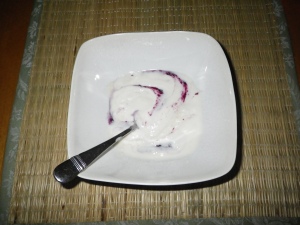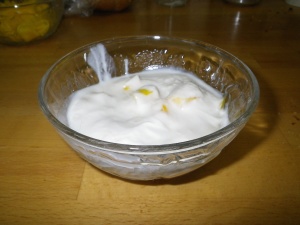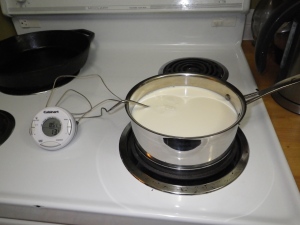First off, my apologies for my long absence from the blogosphere. My son is learning to walk and takes a lot of my time. Then, to top it off, the whole family came down with a stomach flu. It was a quick flu, really, but it left me feeling weak for a couple days. I spent a lot of time sleeping.
Today I shall chronicle our latest foray into condo homesteading – microwave mozzarella. Clearly, cheesemaking is a skill I’ll need when I have goats/cows/sheep and need something to do with all that milk.
We’ve tried this recipe before, with some success. Mister and I decided to give it another go, because there was definitely room for improvement.
The ingredients are pretty simple: 4L of milk, citric acid, rennet, and salt.
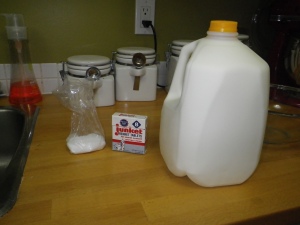
I forgot to put the salt in the photo. Imagine it's there next to the citric acid (the white stuff on the left)
Equipment is also pretty simple: A thermometer, a microwavable bowl, and a big ol’ stainless steel pot.
To start off with, we brought the milk up to room temperature (we heated it on the stove, but you can also leave it on the counter for an hour or so). When it was warm enough, we added the citric acid (we used 1 teaspoon dissolved in a little bit of water). A gentle stir, and it started to curdle immediately. We were thrilled!


Curds

Almost ready for rennet!
Next, we heated the milk to 90 degrees F (I got the recipe from an American magazine and haven’t bothered to do the conversions… sorry fellow Canucks). Then, added the rennet (also dissolved in a small amount of water). We used junkett rennet, because we couldn’t find cheesemaker’s rennet. Even junkett rennet was darn hard to find. Junkett rennet isn’t as good, so you need to use a little more. The recipe called for 1/2 tablet, but we used a whole tablet.

The rennet is dissolved in water so that it distributes evenly
Once the rennet was incorporated, we continued heating to 105 degrees F. At this point we turned off the heat and waited. There was definitely a large curd at the top, but the whey was still pretty milky (it’s supposed to be clear and yellowish). The recipe said if the whey was still milky, wait a while and it will clear up. When this happened last time, Mister got impatient and added more citric acid and rennet (I couldn’t really blame him, we were on a schedule. I’m not sure why we decided to make cheese when we had somewhere else to be later). This time when it happened again, he went straight there. I think the problem might be a little too much milk, since 4L is about a cup more than the gallon that the recipe called for. Either way, it worked to clear up the whey, although the curd was no longer a nice shape and it was hard to tell whether it pulled away from the side of the pot (which is supposed to indicate its coagulated goodness).

Attempting to pull the curd away from the side of the pot. It's pretty mangled.
At this point, we drained the curds and put them in the microwavable bowl. This time, we drained them through cheesecloth. We regretted this decision, though, as it meant a lot of curds were lost in the transfer (a lot of chemists would cringe at the percent yield we got back because so much stuck to that darn cheesecloth!). Last time we just drained them by squeezing them by hand in the bowl.
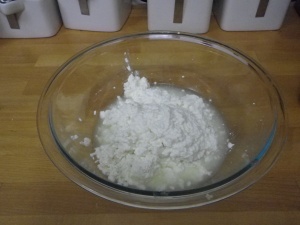
What's left of our curds
Okay. So now comes the microwave part, since I’m sure you’re all wondering why the microwave factors into this. Mozzarella is a stringy, stretchy cheese. In order to get it that way, you need heat. You can dunk it in a bath of boiling hot water… or you can microwave it. We chose microwaving.
The idea was to microwave it for several short bursts, and knead it gently in between. However, it’s darn hard to knead hot cheese curds gently. Mister did his best, since his hands are made of asbestos, but I think we were lacking in the kneading department.

Kneading with a ...spork? A spoon would be a better option
After heating and kneading and heating and kneading, we added salt, then heated and kneaded again. On the last knead, you’re supposed to pull the cheese like it’s taffy. Ours didn’t pull very well, it broke. This was supposed to indicate it was too cold. So we heated again. Then it was too hot to handle.
Next time we’ll buy gloves.
Mister decided he’d had enough of this game, and crammed the cheese into molds.
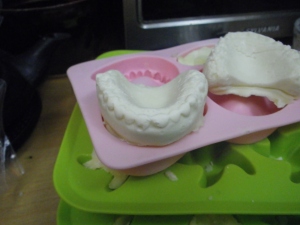
Smile! Cheese dentures.
When it cooled, we tried it. It’s a tiny bit too salty (last time we under salted, this time we added more to compensate, but it was apparently too much) and the texture isn’t quite what I wanted. However, it will still be useful for something. I popped it in the freezer and will use it for French onion soup or something else where the texture isn’t critical.
A fun adventure, even if not the most successful one. We’ll try again later and hopefully it will work out better!












